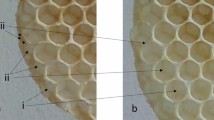Abstract
The nests of European honeybees (Apis mellifera) are organised into wax combs that contain many cells with a hexagonal structure. Many previous studies on comb-building behaviour have been made in order to understand how bees produce this geometrical structure; however, it still remains a mystery. Direct construction of hexagons by bees was suggested previously, while a recent hypothesis postulated the self-organised construction of hexagonal comb cell arrays; however, infrared and thermographic video observations of comb building in the present study failed to support the self-organisation hypothesis because bees were shown to be engaged in direct construction. Bees used their antennae, mandibles and legs in a regular sequence to manipulate the wax, while some bees supported their work by actively warming the wax. During the construction of hexagonal cells, the wax temperature was between 33.6 and 37.6 °C. This is well below 40 °C, i.e. the temperature at which wax is assumed to exist in the liquid equilibrium that is essential for self-organised building.



Similar content being viewed by others
References
Buchwald R, Breed D, Greenberg AR (2008) The thermal properties of beeswaxes: unexpected findings. J Exp Biol 211:121–127
Hepburn HR (1983) Comb construction by the African honeybee, Apis mellifera adansonii. J Entomol Soc South Afr 46:87–101
Hepburn HR (1986) Honeybees and wax: an experimental natural history. Springer, Berlin Heidelberg
Hepburn HR, Muerrle T, Radloff SE (2007) The cell bases of honeybee combs. Apidologie 38:268–271
Karsai I, Pénzes Z (1993) Comb building in social wasps: self-organization and stigmergic script. J Theor Biol 161:505–525
Koeniger N (1970) Über die Fähigkeit der Bienenkönigin (Apis mellifica L.) zwischen Arbeiterinnen- und Drohnenzellen zu unterscheiden. Apidologie 1:115–140
Kurstjens SP, Hepburn HR, Schoening FRL, Davidson BC (1985) The conversion of wax scales into comb wax by African honeybees. J Comp Physiol B 156:95–102
Lau (1959) Beobachtungen und Experimente über die Entstehung der Bienenwabe (Apis mellifica L.). Zool Beitr 4:233–306
Martin H, Lindauer M (1966) Sinnesphysiologische Leistungen beim Wabenbau der Honigbiene. Z Vergl Physiol 53:372–404
Pirk CWW, Hepburn HR, Radloff SE, Tautz J (2004) Honeybee combs: construction through a liquid equilibrium process? Naturwissenschaften 91:350–353
SAS (2002) SAS/STAT user’s guide, version 9.2. SAS Institute, Cary, NC, USA
Stabentheiner A, Kovac H, Brotschneider R (2010) Honeybee colony thermoregulation—regulatory mechanisms and contribution of individuals in dependence on age location and thermal stress. PLoS one 5:e8967
Tautz J (2008) The buzz about bees, biology of a superorganism. Springer, Berlin
Vogt H (1911) Geometrie und Ökonomie der Bienenzelle. Verlag von Trewendt und Granier, Breslau
Werner-Meyer W (1960) Wachs und Wachsbau – Kittharz. Biene und Bienenzucht 1960:202–229
Acknowledgments
We thank Uwe Gerber for the support with constructing the observation unit. We also thank two anonymous referees for their valuable comments. This work was supported by funds from the regional governments of Brandenburg, Berlin, Saxony, Saxony-Anhalt and Thuringia. Part of the equipment used was financed by the European Union (EFRE–Application No. 80137041).
Author information
Authors and Affiliations
Corresponding author
Additional information
Communicated by: Sven Thatje
Electronic supplementary material
Below is the link to the electronic supplementary material.
Online Resource 1
Assembly of the observation hive. The hive was open on one side. A digital infrared camera (a) and a thermographic camera (b) projected directly into the box facing the comb without any foil in between. The box was closed and thermally insulated with styrofoam. Thermo elements (c) and a sensor (d) were used to maintain the temperature manually at ca 30 °C. A glass plate was placed between the cameras to prevent heat transmission. An infrared light source (e) was placed at the bottom (JPEG 6 kb)
Cross section of a comb containing building bees. In this infrared video, the building technique of single bees is shown inside and above the cells (AVI 22777 kb)
Thermographic view of comb building. This video shows the comb building behaviour in a thermographic view. The colour scale provides information about the temperature. A cell was excised in each of windows 1 and 2, and builders performed repair work. The area with warm bees below is the comb edge (AVI 11752 kb)
Online Resource 4
Hexagonal comb cells built by the social wasp Dolichovespula saxonica. Wasps produce hexagonal cells using cellulose as the building material (JPEG 5 kb)
Rights and permissions
About this article
Cite this article
Bauer, D., Bienefeld, K. Hexagonal comb cells of honeybees are not produced via a liquid equilibrium process. Naturwissenschaften 100, 45–49 (2013). https://doi.org/10.1007/s00114-012-0992-3
Received:
Revised:
Accepted:
Published:
Issue Date:
DOI: https://doi.org/10.1007/s00114-012-0992-3



